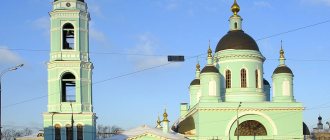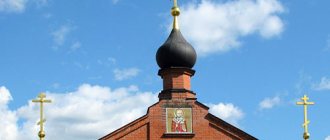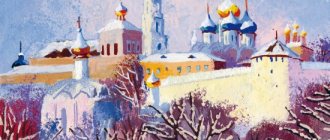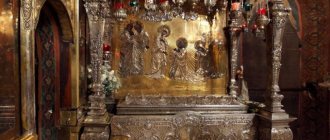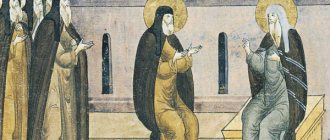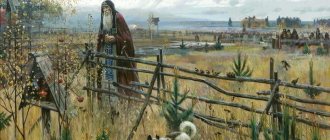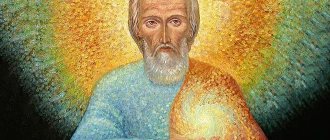The Church of St. Sergius of Radonezh in Krapivniki is one of the oldest in Moscow. It is located opposite the Vysoko-Petrovsky Monastery, founded in the 14th century. The area where the temple was located had several names over time - Old Serebryaky, because mint workers lived here, New Watchmen, because representatives of the palace guard lived here. But in modern times the name Krapivniki has been assigned to this area.
Schedule of services
Those who want to visit the “Church of St. Sergius of Radonezh in Krapivniki” in Moscow at Krapivensky Lane, 4 st2, are most interested in the schedule of services. You can find out in several ways:
- Through the official group on social networks;
- visiting in person;
- by phone number;
- on the official website “Temple of St. Sergius of Radonezh in Krapivniki.”
Brief information about the company:
- Entity:
- Rating: (out of 5)
- Section: Other>Religion
- Short Description:
- Payment Methods:
- Postcode: 127051
To find out the schedule of services, go to the official website using the link or call the phone number “Temple of St. Sergius of Radonezh in Krapivniki.” They will tell you what time is best to come and answer other questions.
Description
There were different periods in the history of the temple, but its final appearance was formed in the second half of the 18th century and in architectural terms the church was the following structure:
- the first tier of the temple was originally placed on a quadrangle, the corners of which were cut off;
- windows are inserted into the main faces;
- in the intermediate niches of the faces there are arched windows;
- the first tier of the bell tower is a cubic volume with rustication;
- the second tier is an equilateral octagon.
Temple icon of St. Sergius of Radonezh
That is, the Sergius Church is fully formed in the Baroque architectural style, with some elements of a modern vision of the external structure of the temple.
Kiysky cross
Krapivensky Lane has been known since the beginning of the 17th century, but for a long time it was an alley on the outskirts of the Vysoko-Petrovsky Monastery. And here there is its own pearl - the Church of St. Sergius of Radonezh, which is in Starye Serebrenniki or Storozhi. After the temple, the lane was called Sergievsky or Old Serebrenitsky. But at the beginning of the 19th century it was renamed Krapivensky, and the church also got a new name.
According to one version, there was a remote area with nettles; according to another, the name of Krapivensky Lane was given by the name of the homeowner Alexei Krapivin.
Also here could be a settlement of wrens, who were engaged in the preparation of nettles. In the old days, it was finely chopped, mixed with flour and fed to horses and pigs. And cabbage soup was made from young nettles.
In 1625, the Church of Sergius of Radonezh appeared in Krapivniki. In 1678, a pillarless building was built on the site of a burnt wooden church, and in 1749 it was rebuilt, a second tier was added and a bell tower was erected. Around the same time, the refectory and chapel of John the Baptist appeared. The project for rebuilding the temple was presumably prepared by an architect from the team of D.V. Ukhtomsky.
In 1883, the Church of St. Sergius of Radonezh in Krapivniki, which did not have its own parish, was transferred to the Patriarchal Metochion of Constantinople, and a complex of three-story buildings designed by S.K. Rodionova. The facade was decorated with Byzantine, Old Russian and Muslim ornaments. So the architect wanted to show that the ancient Patriarchate is located in a Muslim country, but the courtyard is on Russian soil. For a long time, the temple was also the tomb of the Ukhtomskys.
In 1938, the church in Krapivniki and the courtyard were closed, and the bell tower was partially dismantled. Skate production was set up inside, since the Petrovsky skating rink was nearby.
In 1991, the temple was returned to the Russian Orthodox Church. Now its most famous shrine is the Kiy Cross with the relics of 400 saints, although some of them have been lost. It was made for the Kiysk Monastery in memory of the miraculous rescue of Patriarch Nikon from a storm on the White Sea. Cypress was brought from Jerusalem especially for this cross. The size of the shrine exactly repeats the cross on which Jesus Christ was crucified. The cross was covered with silver sheets, and particles of the Lord's cross and parts of Christ's robe were placed inside. It was decorated with 15 gilded stars with particles of the Holy Sepulcher, parts of the Nativity scene stone and parts of the coffin of the Virgin Mary. On the front side of the cross there are the relics of 97 saints with signatures, and on the back there are the relics of another 300 saints without signatures.
In the 1930s, the Kiy cross was in the anti-religious museum on Solovki, then it was kept in the storerooms of the State Historical Museum. In 1991, the shrine was transferred to the Church of St. Sergius of Radonezh in Krapivniki.
On March 31, 2022, a pilgrimage trip to the ancient Moscow church of St. Sergius of Radonezh in Krapivniki took place. An excursion was held in the temple, where we were told about the history of the temple, its shrines and attractions. The main shrine of the Kiysky Cross temple is the reliquary of Patriarch Nikon, it contains about 300 pieces of relics of saints. We prayed at this shrine. In the left aisle of the temple we were shown an unusual iconostasis by sculptor Sergei Antonov; the icons in it were made in the style of stone carving. At the northern wall of the temple there are tombstone slabs with funeral inscriptions of the Ukhtomsky family. Our excursion ended with a visit to the museum “Soviet Union: Faith and People,” which is located at the temple. Artifacts of the 20th century are lovingly collected in it, making it possible to restore the atmosphere of life of Orthodox Christians.
Text - Svetlana Kiseleva
Photo - Alexey Dubovichenko, priest. Vladislav Mishin
About company
You will find the company Temple of St. Sergius of Radonezh in Krapivniki in Moscow at Krapivensky Lane, 4
For more information on opening hours, prices and other information, please call +7 495-62-34-780
You can also obtain certain information on the company’s website krapivniki.ru
You can send a question or provide other information by email.
Field of activity - Orthodox religious institutions
- Add to friends
- RSS
pupil
LIVE AND LEARN.
A mutilated altar in the ancient church of St. Sergius of Radonezh in Krapivniki *.
The central lectern and candlesticks are now in the “loft” style.
(a la industrial interior). Temple of St. Sergius of Radonezh in Krapivniki - Patriarchal Metochion, rector Archpriest.
Alexander Abramov. Abuse
was accomplished above the limit of the Rev.
Seraphim of Sarov. First,
Met.
ALFEEV
Hilarion
handed over a particle of the relics of Father Seraphim to the Latins
,
and now
(isn’t this a blessing?)
the side-chapel of the saint has been latinated
.
The priest (on the right, with a bald Jesuit face) also got platinum. ———————— * ABOUT THE PEARL THAT WAS SPRAYED WITH ACID.
Temple of St.
Sergius in Krapivniki or
a miraculously preserved pearl of Orthodox architecture
. It is not big at all, and the gaze of a person interested in the history of his native city immediately stops at it, and a feeling of warmth and quiet joy appears in his soul. ...
Here you can truly feel the spirit of Old Moscow
, which carries their personal feelings and experiences. Temple in the name of St. Sergius of Radonezh, which is in Krapivniki, “in Starye Serebryaniki”, “in Starye Storozhi”, “on Truba”, is the very first temple in the name of St. Sergius within the White City. It has been known since 1591...
During the French invasion in 1812, the church was looted and badly damaged
. By Decree of the Holy Synod of 04/09/1813. she was assigned as a homeless person to Ts. Gregory the Theologian, which is near Dmitrovka. After the abolition of the Sergius parish, the houses of the clergy were dismantled, and in 1828 the headman and parishioners of the church. Gregory turned to Metropolitan. Moscow Philaret (Drozdov) with a request for permission to dismantle the dilapidated Sergius Church and use the material to build houses for the clergy.
The Metropolitan did not approve of this initiative, wishing to preserve the holy temple intact... In 1883, by decree of Alexander III of November 15, the temple of St. Sergius was transferred to the Patriarchate of Constantinople
y for the construction of a courtyard, and the church came into the possession of the courtyard along with the adjacent land plot.
To the façade
e, facing the northern wall
of the temple, stone memorial plaques with inscriptions in Greek and Russian have been preserved:
“
During the reign of Alexander III, a courtyard was opened under the Ecumenical Patriarch Joachim III,
in the summer of 1883. The buildings of this Constantinople courtyard were erected under the Patriarchate of Dionysius V, under its first rector, Archimandrite. Seraphim, in 1887–1892."
In the 1920s of the XX century
Sergius Church as an ancient monument was registered in the Museum Department of the People's Commissariat for Education.
Being a metochion of the Patriarchate of Constantinople, the temple remained active for quite a long time
. In the 1920s–1930s, its rector was Archimandrite Vasily (Dimopulo). In 1922, valuables were confiscated from the Church of St. Sergius, and the confiscation was accompanied by riots. ...
02/05/1938. The Moscow Regional Executive Committee decided to close the church
. After the closure, the upper tier of the bell tower was destroyed, new windows were broken into the walls, and a door was opened in the central apse. The building of the temple housed the workshop of the 1st Moscow skate factory.
The temple was first mentioned in 1625, and its stone building was built in 1678 on the site of a burnt wooden temple. The main thing is the throne of Sergius of Radonezh. The chapels of the Beheading of John the Baptist and St. Nicholas the Wonderworker, known since 1652 and 1722, respectively.
In 1749, the temple was rebuilt in the Russian Baroque style, a new dome and a two-tier bell tower were built. In 1883, the temple was transferred to establish a metochion of the Patriarch of Constantinople. Closed at the end of the 1930s, the top of the bell tower and the chapter were dismantled. Regular services were resumed only in 1991.
In 1993, the Lyceum of Spiritual Culture in the name of St. Seraphim of Sarov was opened at the temple.
The temple was restored in 2002–2003. The bell tower was restored.
Estimated reading time: less than a minute.
On January 15, in the capital's church of St. Sergius of Radonezh in Krapivniki, a chapel painting is unveiled, made in a unique style of pastel colors, reminiscent of the works of ancient masters.
The Church of St. Sergius of Radonezh, located in an alley on the Boulevard Ring of Moscow, was the central temple of the capital of the 17th century.
The painting presented in it was done by masters of painting and architecture - the spouses painter Irina Zaron and sculptor Sergei Antonov .
The works of masters who offer their vision of contemporary art are exhibited in many museums around the world - the Tretyakov Gallery, the Russian Museum of St. Petersburg, Paris and other galleries.
“Our task is to show people the continuity of times, to convey the simple idea that a masterpiece is not necessarily something from the past, there are masterpieces in our present. This is important for me both as a priest, and as a historian and simply a modern person who is not indifferent to the culture of our country,” said the rector of the church, Archpriest Alexander Abramov .
The temple itself contains many shrines - the Kiysky Cross with particles of the relics of 300 saints, revered icons of the 16th-18th centuries.
On the same day, one of the first private lyceums - a spiritual culture named after St. Seraphim of Sarov, cared for by the clergy of the temple, turns 20 years old.
Address of the temple: Krapivensky lane, 4, building 2 (metro stations "Chekhovskaya", "Pushkinskaya").
Audio
Share:
Like:
Activities of the parish
Over the decades after the opening of the temple, a community was formed here, which developed active efforts to catechesis the local population and attract people to the current tasks facing the community of the St. Sergius Church.
- There is a Sunday school for both children and adults.
- A pilgrim group has been organized that travels to all the holy places of Russia.
- There is a volunteer team that is engaged in social activities.
All this suggests that the community is developing quite active activities in the territory under its jurisdiction.
Latest TV shows
- August 3, 2022 “At the bookshelf” (Ekaterinburg)
By the bookshelf. Invisible wings
July 30, 2022 “At the bookshelf” (Ekaterinburg)
By the bookshelf. Spiritual alphabet
July 28, 2022 “At the bookshelf” (Ekaterinburg)
By the bookshelf. The Tale of the Holy Equal-to-the-Apostles Prince Vladimir
July 27, 2022 “At the bookshelf” (Ekaterinburg)
By the bookshelf. The boring life of an Orthodox missionary
July 26, 2022 “Reading the Philokalia” (Ekaterinburg)
We read the Philokalia. 26 July. Priest Konstantin Korepanov
Questions and answers
Is it permissible not to receive communion while attending the liturgy?
- Now it is permissible, but in each specific case this is a pastoral question. We need to understand why this happens. In any case, the sacrament must be, one way or another, regular.
What is the point of secret prayers if parishioners do not hear them?
— Secret prayers apparently became secret in an era when people began to receive communion very rarely. And since people do not fully participate in the Eucharist, the clergy counted.
What was the preparation for communion among the first Christians?
- Hard to say. Of course, this preparation did not consist of reading some special sequence and, perhaps, a three-day fast, as is customary today. In general, it must be said.
How did a full meal become a modern ritual?
“Indeed, we know that the Lord Himself broke bread and gave it to His disciples. And the first Christians also gathered together, made offerings of bread and wine, which...
© 1999-2021 Ekaterinburg Diocesan Information and Publishing Center
All materials of the Internet portal of the Ekaterinburg diocese (texts, photographs, audio, video) can be freely distributed by any means without any restrictions on volume and timing, subject to reference to the source (“Orthodox newspaper”, “Radio “Resurrection”, “TV channel” Union"). No additional approval is required for reprinting or other reproduction.
Patronal holidays and services
All thrones are associated with saints:
- St. Sergius of Radonezh is celebrated on October 8;
- St. Seraphim of Sarov January 15;
- All Russian Saints are celebrated on the second week after the Holy Trinity.
Morning services on weekdays begin at 8.00, on holidays and Sundays the second liturgy is served at 10.00 in the morning. Vespers service begins at 17.00.
Services are performed daily.
